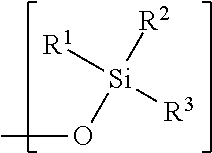Hydrophobic polysaccharides with silyl ether linkages having enhanced degradation and medical articles made therefrom
a technology of silyl ether and polysaccharide, which is applied in the field of hydrophobic derivatives of polysaccharides, can solve the problems of acidic degradation products generated upon their hydrolysis, difficult to prepare such forms using conventional biodegradable polymers, and remains very technical challenges, etc., to achieve shortening the period of implantation, increasing the susceptibility of linker segments, and fast degradation rates
- Summary
- Abstract
- Description
- Claims
- Application Information
AI Technical Summary
Benefits of technology
Problems solved by technology
Method used
Image
Examples
example 1
Preparation of Fractionated Maltodextrin
[0134]Maltodextrin was purchased from Roquette, France (Glucidex™ 2, MWave 320 kDa) or Grain Processing Corporation, Muscatine, Iowa (M040 MWave 55 kDa). The 55 kDa maltodextrin was used as received. Glucidex™ 2 was further fractionated to a narrower polydispersity. Glucidex™ 2 maltodextrin (MD; 500 g; DE=3 max) was dissolved in deionized water to a total volume of 5 L with stirring, and diafiltered using a 500 kDa molecular weight cut-off cassette, ant the permeate (flow through) was kept. The permeate was then diafiltered using a 100 kDa weight cut-off cassette and the retenate was kept. The solution was concentrated down to 3 L and then lyophilized. 310 g of maltodextrin (100-500 kDa) was isolated (62% yield).
example 2
Method of Making Maltodextrin-Dimethyldecylsilyl Ether
[0135]Maltodextrin (Glucidex 2, 1 g) was placed into 25 mL oven-dried round-bottom flask equipped with the stir bar, under inert atmosphere of nitrogen. DMSO (10 mL) was added and mixture was stirred at room temperature until maltodextrin dissolved. 1-methylimidazole (3 mL, 37.6 mmol) was added at once and solution was allowed to stir for additional 5 min. Chlorodecyldimethylsilane (5 mL, 18.4 mmol) was added dropwise via syringe. Reaction was allowed to stir at room temperature for additional 16 hr. At which point, liquid layer was decanted keeping precipitate inside. Crude product was dissolved in CH2Cl2 filtered and solvent was evaporated in vacuo. Product was further dried in vacuo resulting in viscous oil.
example 3
Method of Making Maltodextrin-Dimethylbutylsilyl Ether
[0136]Maltodextrin (Glucidex 2, 1 g) was placed into 50 mL oven-dried round-bottom flask equipped with the stir bar, under inert atmosphere of nitrogen. DMSO (10 mL) was added and mixture was stirred at room temperature until maltodextrin dissolved. 1-methylimidazole (1.1 mL, 13.8 mmol) was added at once and solution was allowed to stir for additional 5 min. Chlorobutyldimethylsilane (2.1 mL, 12.2 mmol) was added via syringe dropwise. White gel-like precipitate appeared and floated to the top of the reaction mixture. Reaction was allowed to stir at room temperature for additional 2 hr. At which point, reaction mixture was poured into MeOH (150 mL) and white precipitated formed. Liquid layer was decanted and crude product was washed with MeOH (3×10 mL). Product was further dried in vacuo to obtain solid.
[0137]Several maltodextrin-dimethylalkylsilyl ethers were made according to method 4 and 5. They are summarized in Table 1.
TABLE ...
PUM
| Property | Measurement | Unit |
|---|---|---|
| Fraction | aaaaa | aaaaa |
| Weight ratio | aaaaa | aaaaa |
| Hydrophobicity | aaaaa | aaaaa |
Abstract
Description
Claims
Application Information
 Login to View More
Login to View More - R&D
- Intellectual Property
- Life Sciences
- Materials
- Tech Scout
- Unparalleled Data Quality
- Higher Quality Content
- 60% Fewer Hallucinations
Browse by: Latest US Patents, China's latest patents, Technical Efficacy Thesaurus, Application Domain, Technology Topic, Popular Technical Reports.
© 2025 PatSnap. All rights reserved.Legal|Privacy policy|Modern Slavery Act Transparency Statement|Sitemap|About US| Contact US: help@patsnap.com



